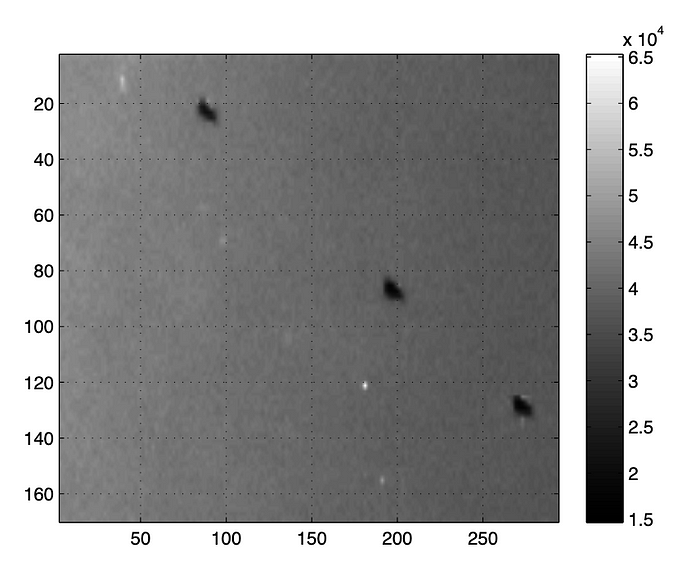“Down To Earth” Limits on Unidentified Aerial Phenomena in Ukraine

Over the past two weeks I was bombarded by a dozen requests to read a new report by astronomers on Unidentified Aerial Phenomena (UAP) in Ukraine. My response to all of these messages was the same: “I am not sure what to make of the report. Ukraine is in a military conflict with a lot of human-made activity in the sky. This must introduce a lot of noise for any search for objects that are not human-made. In science we aim to maximize the signal-to-noise ratio, and so Ukraine would be the last place on Earth where I would initiate UAP studies.”
But last evening I received a special request from a high-level official in the US government to summarize my thoughts on observable signatures of UAP and so this morning I checked the UAP report from Ukraine and wrote a paper about it a few hours later.
The Ukranian paper reports about two types of objects: luminous and dark. The dark objects with no visible emission were labeled as ``Phantoms’’. They were characterized by a size of 3–12 meters and speeds up to 15 kilometers per second at a distance of up to 10–12 kilometers. If real, such objects exceed the capabilities of human-made aircrafts or rockets. I quickly realized that the distance of these dark objects must have been incorrectly overestimated by an order of magnitude, or else their bow shock in the Earth’s atmosphere would have generated a bright fireball with an easily detectable optical luminosity.
The interest in UAP stems from their potential non-human origin. Extraterrestrial equipment could arrive in two forms: space trash, similar to the way our own interstellar probes (Voyager 1 & 2, Pioneer 10 & 11 and New Horizons) will appear in a billion years, or functional equipment, such as autonomous devices equipped with Artificial Intelligence (AI). The latter would be an ideal choice for crossing the tens of thousands of light years that span the scale of the Milky Way galaxy and could survive even if the senders are not able to communicate.
It is likely that any functional devices embedded in the Earth’s atmosphere are not carrying biological entities because these would not survive the long journey through interstellar space and its harsh conditions, including bombardment by energetic cosmic-rays, X-rays and gamma-rays. Interstellar gas and dust particles deposit a kinetic energy per unit mass that exceeds the output of chemical explosives at the speed of tens of kilometers per second characterizing rockets. However, technological gadgets with AI can be shielded to withstand the hazards of space, repair themselves mechanically, or even reproduce given the resources of a habitable planet like Earth. With Machine Learning capabilities, they can adapt to new circumstances and pursue the goals of their senders without any need for external guidance.
As argued by John von Neumann in 1939, the number of such devices could increase exponentially with time if they self-replicate, a quality enabled by 3D printing and AI technologies. Physical artifacts might also carry messages, as envisioned by Ronald Bracewell in 1960.
In principle, the fastest gadgets could be launched by lightsails, pushed by powerful light beams up to the speed of light. Natural processes, such as stellar explosions or gravitational slingshot near black hole pairs, could launch objects to similar speeds. However, it would be difficult for relativistic payloads to slow down below the escape speed of Earth, smaller by 4.5 orders of magnitude than the speed of light, without having around the same facilities that generated their high initial speeds.
A better suited propulsion technique that was used in all space missions from Earth is chemical rockets. Since rockets carry their fuel, they can navigate to a desired planet and slow down near it.
The tyranny of the rocket equation, requiring that the fuel mass must increase exponentially with increasing terminal speed, explains why all human-made spacecraft reached a speed limit of tens of kilometers per second, 4 orders of magnitude below the speed of light. Interestingly, this speed is comparable to the escape speed from the Earth’s orbit around the Sun, 42 kilometers per second, making it possible for humanity to launch probes to interstellar space by taking advantage of the motion of the Earth around the Sun at 30 kilometers per second. Chemical propulsion may not be sufficient for probes to escape from the habitable zone around dwarf stars, like the nearest star, Proxima Centauri.
In summary, chemical propulsion allows escape from the habitable zone of Sun-like stars and enables slowing down near a destination. The Ukranian report suggests objects with comparable speeds of up to 15 kilometers per second.
Devices which need to refuel would favor a habitable planet where liquid water or combustible organic fuel are available. Planets can be identified from a distance as they transit their star or through direct imaging. Once an Earth-like planet is targeted, an interstellar device can plunge into its atmosphere. In principle, a multitude of tiny devices can be released from a mothership that passes near Earth.
At a final speed of 30 kilometers per second, a probe would cross twice the distance of the Sun from the Milky-Way center within a time of half a billion years. The fraction of all Sun-like stars that host Earth-like planets in their habitable zone is in the range 3–100%. This implies that self-replicating probes could reach ten billion habitable planets around Sun-like stars in less than a billion years. Since most stars formed more than a billion years before the Sun, it is possible that other technological civilizations predated ours by the amount of time needed for their devices to reach Earth.
My paper points out that any supersonic motion of such devices through the Earth’s atmosphere would inevitably be accompanied by optical emission.
I showed that an object with a frontal cross-sectional area of 10 square meters, moving at a supersonic speed of 10 kilometers per second must create a bow shock in the Earth’s atmosphere and dissipate a mechanical power of 1.5 terra-Watt at an elevation of 10 kilometers. Data on meteors implies that about a tenth of the kinetic power is radiated away in the optical band, implying that the reported properties of the phantom objects above Ukraine would result in fireball of visible luminosity above 150 giga-Watt. For a path length 10 kilometers, the emission would last at least a second and cannot be missed.
I concluded that the reported speeds and sizes of the ``phantom’’ objects would have generated fireballs of detectable optical luminosity at their suggested distances, and so these objects could not have appeared dark. However, if the phantom objects are ten times closer than suggested, then their angular motion on the sky corresponds to a physical velocity that is ten times smaller, 1.5 kilometers per second and their inferred transverse size would be 0.3–1.2 meters, both characteristic of artillery shells.
The inferred fireball luminosity scales with distance to the 5th power, and is reduced to a modest level of a few mega-Watts if the distance is shorter by a factor of ten than suggested by the Ukranian astronomers. If the artillery shells have a frontal diameter of only 10 centimeters, then the inferred fireball luminosity is merely 10 kilo-Watts, which at a kilometer distance would appear extremely faint like a 100-Watt light bulb at a distance of 100 meters.
After correcting the factor of ten overestimate in distance, everything falls into place with the parameters of artillery shells. As the Nobel Laureate physicist Richard Feynman noted in the title his book: there is a great pleasure in finding things out. There is no way out of the above mentioned arguments because the Ukranian astronomers saw the objects as dark, meaning that they block the background light from the sky . The required electromagnetic cross-section for interaction with light implies that the phantom objects must also interact with air molecules. Admittedly, the dark objects could also be bullets from a machine gun at a distance of 100 meters instead of artillery shells at a distance of a kilometer. All I am saying is that the distance must be smaller than claimed by at least an order of magnitude. I have no idea about the type of military equipment being used in the area, but the nature of the objects cannot be what the astronomers claim.
The Ukrainian astronomers also identified a luminous and variable object at an altitude of 1,170 kilometers, which was detected through two-site observations above Ukraine. This object is likely a satellite.
Altogether, “down to Earth” explanations can account for the reported UAP above Ukraine. But in salute to my colleagues in Ukraine, let me conclude with a quote from Oscar Wilde: “We are all in the gutter, but some of us are looking at the stars.”
On October 6, 2022, a Hungarian magazine article concluded with the following paragraphs:
“The relevant Kyiv observatory (Main Astronomical Observatory of the National Academy of Sciences of Ukraine/MAO NASU) issued a statement that confirms Loeb’s conclusion. Accordingly, the sightings were made in the observatory’s test mode during a planned meteor observation, and the results were not discussed or reviewed with the observatory. Due to the media uproar, the observatory convened a seminar on the case on September 15, at which the following important conclusions were reached:
“The observations of Zhilyaev and his colleagues are original, but the processing and interpretation of the results was done at an inadequate scientific level and with significant errors in determining the distance of the observed objects. Also, the dates of the sightings are missing from the article; the authors do not indicate which events were observed from two locations simultaneously; the authors do not provide arguments that the observed UAPs may include natural phenomena or artificial objects of terrestrial origin (meteors; objects carried by the wind over long distances; space debris, etc.). Instead of a critical analysis of the observations (possible errors, the adequacy of the models, the accuracy of the post-processing), the authors postulate unjustified conclusions about the characteristics of the observed objects as UAPs. The MAO Academic Council of NASU believes that the above-mentioned B.E. Zhilyaev’s conclusion was hasty and did not meet the professional requirements for publishing the results of scientific research.””
ABOUT THE AUTHOR

Avi Loeb is the head of the Galileo Project, founding director of Harvard University’s — Black Hole Initiative, director of the Institute for Theory and Computation at the Harvard-Smithsonian Center for Astrophysics, and the former chair of the astronomy department at Harvard University (2011–2020). He chairs the advisory board for the Breakthrough Starshot project, and is a former member of the President’s Council of Advisors on Science and Technology and a former chair of the Board on Physics and Astronomy of the National Academies. He is the bestselling author of “Extraterrestrial: The First Sign of Intelligent Life Beyond Earth” and a co-author of the textbook “Life in the Cosmos”, both published in 2021.
